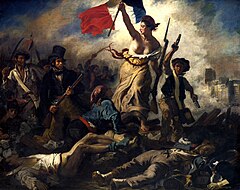
Back Julirevolution ALS ثورة يوليو 1830 Arabic Revolución de 1830 AST İyul inqilabı Azerbaijani Ліпеньская рэвалюцыя Byelorussian Ліпеньская рэвалюцыя 1830 году BE-X-OLD Юлска революция (1830) Bulgarian জুলাই বিপ্লব Bengali/Bangla Reveulzi Gouere Breton Julska revolucija BS
You can help expand this article with text translated from the corresponding article in French. Click [show] for important translation instructions.
|
| Part of the Bourbon Restoration and the Revolutions of 1830 | |
 | |
| Date | 26–29 July 1830 |
|---|---|
| Location | France |
| Also known as | The July Revolution |
| Participants | French society |
| Outcome |
|
| History of France |
|---|
 |
| Topics |
| Timeline |
|
|
The French Revolution of 1830, also known as the July Revolution (French: révolution de Juillet), Second French Revolution, or Trois Glorieuses ("Three Glorious [Days]"), was a second French Revolution after the first in 1789. It led to the overthrow of King Charles X, the French Bourbon monarch, and the ascent of his cousin Louis Philippe, Duke of Orléans. After 18 precarious years on the throne, Louis-Philippe was overthrown in the French Revolution of 1848.
The 1830 Revolution marked a shift from one constitutional monarchy, under the restored House of Bourbon, to another, the July Monarchy; the transition of power from the House of Bourbon to its cadet branch, the House of Orléans; and the replacement of the principle of hereditary right by that of popular sovereignty. Supporters of the Bourbons would be called Legitimists, and supporters of Louis Philippe were known as Orléanists. In addition, there continued to be Bonapartists supporting the return of Napoleon's descendants.
© MMXXIII Rich X Search. We shall prevail. All rights reserved. Rich X Search